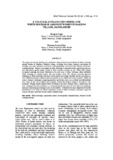A cultural explanatory model for white discharge amongst women in Kakboo village, Bangladesh
Abstract
This paper presents the findings of a qualitative study of women's perceptions of white discharge among women of NagPara, Kakaboo village, including local terms, women's perceptions of etiology, associated symptoms and health seeking pathways and factors that influence treatment-seeking behavior. Women’s perception of white discharge is embedded in the reproductive process and unfavorable gender norms related to their everyday realities of life. While 60% women recognized marriage and heavy workload as the root cause of white discharge, others attributed white discharge to external factors like hot weather. Over 50% women co-related physical symptoms of white discharge with their overall family and village situation and the consequences were attributed not only to physical but also mental, socio-cultural and sexual elements. Culture of silence, women’s autonomy, competing priorities and factors such as accessibility and affordability were some of the socio-cultural and economic factors that shaped women’s decision to seek treatment. Though women reported white discharge as the most common illness, women may not have confirmed infection and there is a strong possibility that some of these physical complaints represent underlying psychological and social conflicts. It therefore becomes important for health practitioners to be aware of cultural explanatory model of white discharge, to promote improved clinical outcomes and better doctor-patient communication.

